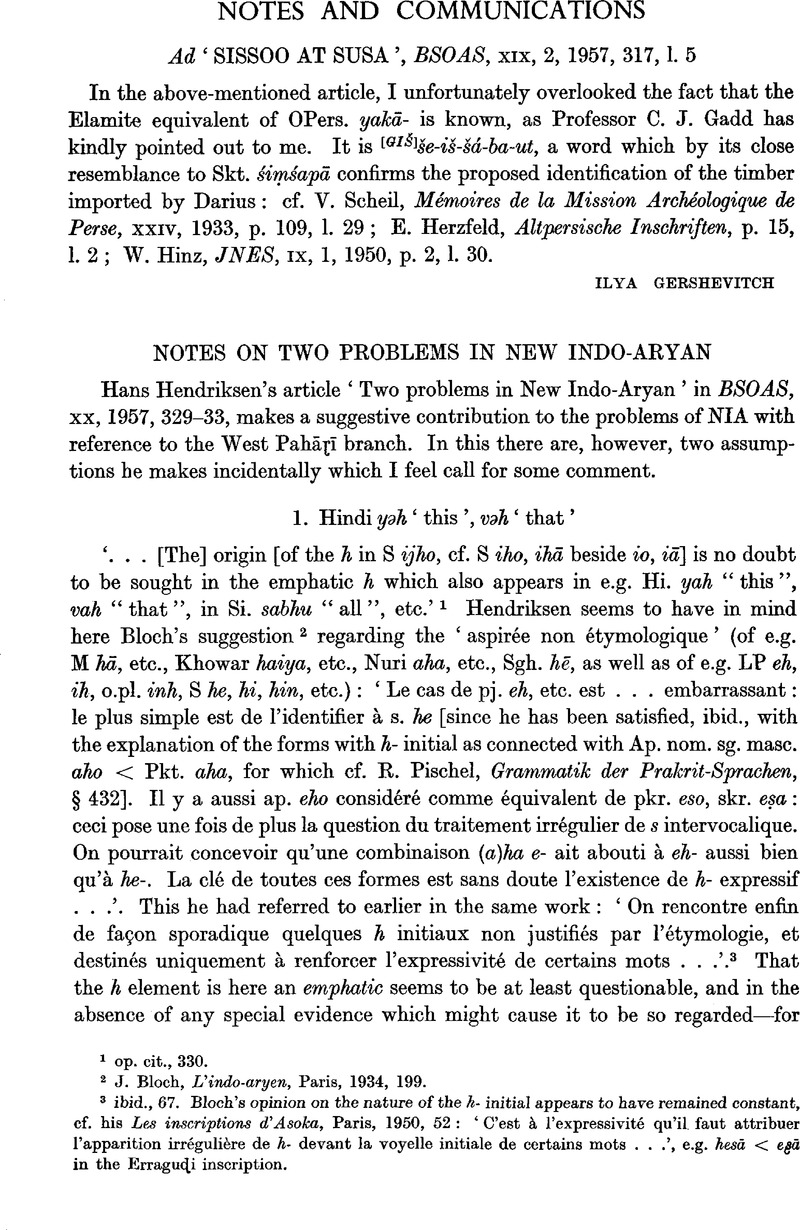No CrossRef data available.
Article contents
Notes on Two Problems in New Indo-Aryan
Published online by Cambridge University Press: 24 December 2009
Abstract

- Type
- Notes and Communications
- Information
- Bulletin of the School of Oriental and African Studies , Volume 21 , Issue 1 , February 1958 , pp. 174 - 178
- Copyright
- Copyright © School of Oriental and African Studies, University of London 1958
References
page 174 note 1 op. cit., 330.
page 174 note 2 Bloch, J., L'indo-aryen, Paris, 1934, 199.Google Scholar
page 174 note 3 ibid., 67. Bloch's opinion on the nature of the h– initial appears to have remained constant, cf. his Les inscriptions d'Asoka, Paris, 1950, 52:Google Scholar ‘C’est à l'expressivité qu'il faut attribuer l'apparition irrégulière de h– devant la voyelle initiale de certains mots …’, e.g. hesā < ![]() in the Erraguɖi inscription.
in the Erraguɖi inscription.
page 175 note 1 It may not be inappropriate to add here that the necessity of using this review as an indispensable adjunct to Bloch's book is yet another measure of Sir Ralph's greatness in the Indo- Aryan sphere. His reviews, which were not included in the bibliography of his works in BSOAS, XX, are of great significance in Indo-Aryan linguistics.
page 175 note 2 cf. also Baburam Saksena, Evolution of Awodhi, § 245. The Ap. forms nom. sg. m. jehe, f. jehĩ are also relevant here.
page 175 note 3 cf. Allen, W.S.,‘Some prosodic aspects of retroflexion and aspiration in Sanskrit’, BSOAS, XIII, 4, 1951, 944Google Scholar (discussing the Skt. aspect of ‘Grassman's Law’).
page 175 note 4 cf. Saksena, op. cit., §§ 244, 241.
page 175 note 5 Bloch, L'indo-aryen, 197–8.
On the initial h– of the Marāthī forms hā, etc., cf. Tagare, G.V., Historical grammar of Apabhraṁśsa, Poona, 1948, § 124,Google Scholar specially p. 233. A study of the Southern ![]() forms in the
forms in the ![]() (ed. L. Alsdorf, Hamburg, 1936) is instructive here.
(ed. L. Alsdorf, Hamburg, 1936) is instructive here.
page 176 note 1 The forms in use in modern KhaΓī Bolī are, however, [jo;] m. ![]() f., [υo] m.
f., [υo] m. ![]() f., contra m.f.pl. [je] [υe]; the pl. forms corresponding to H
f., contra m.f.pl. [je] [υe]; the pl. forms corresponding to H ![]() show no aspiration: [inẽ], [unẽ] (from unpublished material collected by my colleague, Mr. Ganesh Dutt Gaur, to whom I am indebted for this information).
show no aspiration: [inẽ], [unẽ] (from unpublished material collected by my colleague, Mr. Ganesh Dutt Gaur, to whom I am indebted for this information).
In this sense KhaΓi Bolī (KB) is used to refer to the speech (bolī) of the Meerut area; this is the local term actually in use, and it seems preferable to employ it in preference to Grierson's rather cumbersome ‘Vernacular Hindōstānī’.
page 176 note 2 La formation de la langue marathe, § 246.
page 176 note 3 cf. Burton-Page, , ‘Compound and conjunct verbs in Hindi’, BSOAS, XIX, 3, 1957, 471–2.Google Scholar
page 176 note 4 The transcription differs from that which I normally use by writing ā, ī, ū for aa, ii, uu; cf. my ‘The syntax of participial forms in Hindi’, BSOAS, XIX, 1, 1957, 94, n. 1.Google Scholar
page 177 note 1 The anacoluthon of the translation follows that of the Hindi.
page 177 note 2 cf. n. 1, p. 176.
page 177 note 3 Saksena, op. cit., § 315 (a).
page 177 note 4 Here with ‘personal endings’, -tum, -te, -ti∫, -to, -ten; cf. S. K. Chatterji, The origin and development of the Bengali language, § 693, and, for examples, W. Sutton Page, An introduction to colloquial Bengali, 150–1. The corresponding Oriya forms are significant in retaining -nt-, cf. Chatterji, op. cit., § 694.
page 177 note 5 cf. also Tessitori, L.P., ‘Notes on the grammar of the Old Western Rajasthani’, IA, XLIV, 1915, §§ 113,Google Scholar 123, and Mārkaṇḍeya's PrākΓtasarvasva, XVII, 62: sarvadā ∫atΓ: honto bhavan babhūva ![]() vā.
vā.
page 177 note 6 op. cit., 332




